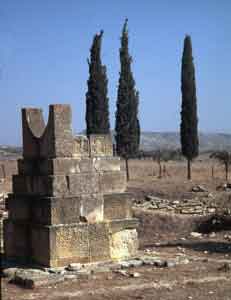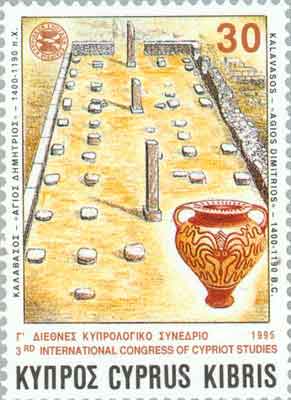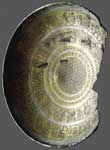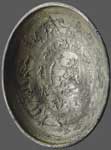.

The Prehistoric Period is the oldest part of Cypriote history.
Epipalaeolithic
Cyprus was not settled in the old stone age, which led to the survival of numerous dwarf forms, such as dwarf elephants (Elephas cypriotes) and pygmy hippos (Phanourios minutis) well into the Holocene. There are claims of an association of this fauna with artefacts of Epipalaeolithic foragers at Aetokremnos near Limassol on the southern coast of Cyprus.
Neolithic
Aceramic Neolithic
The first undisputed settlement (PPNB) occurred in the 9th (or perhaps 10th) millennium BC. The first settlers were already agriculturalists, but did not yet produce pottery (aceramic Neolithic). They introduced the dog, sheep, goats and maybe cattle and pigs as well as numerous wild animals like foxes (Vulpes vulpes) and Persian fallow deer (Dama mesopotamica) that were previously unknown on the island. The PPNB settlers built round houses with floors made of terrazzo of burned lime (e.g. Kastros, Shillourokambos, Tenta) and cultivated einkorn and emmer. Pig, sheep, goat and cattle were kept, but remained morphologically wild. Evidence for cattle (attested at Shillourokambos) is rare and when they apparently died out in the course of the 8th millennium they were not reintroduced until the early Bronze Age.
In the 6th millennium BC, the aceramic Khirokitia culture (Neolithic I) was characterised by round houses (tholoi), stone vessels and an economy based on sheep, goats and pigs.The daily life of the people in those neolithic villages was spent in farming, hunting, animal husbandry and the lithic industry, while homesteaders (likely women) were engaged in spindling and weaving cloths, in addition to their probable participation in other activities. The lithic industry was the most individual feature of this aceramic culture and innumerable stone vessels made of grey andesite have been discovered during excavations.The houses had a foundation of river pebbles, the remainder of the building was constructed in mudbrick. Sometimes several round houses were joined together to form a kind of compound. Some of these houses reach a diameter of up to 10 m. Inhumation burials are located inside the houses.
Plant remains indicate the cultivation of cereals, lentils, beans, peas and a kind of plum called Bullace. Remains of the following animal species were recovered during excavations: Persian fallow deer, goat, sheep, mouflon and pig. More remains indicate Red deer, Roe deer, a kind of horse and a kind of dog but no cattle as yet.
Life expectancy seems to have been very short; the average age at death appears to have been about 34 years, and there was a very high infant mortality rate.
Ceramic Neolithic
The aceramic civilisation of Cyprus came to an end quite abruptly around 6000 BC. It was probably followed by a vacuum of almost 1.500 years until around 4500 BC when we have the emergence of Neolithic II (Ceramic Neolithic).
At this time newcomers arrived in Cyprus introducing a new neolithic era. The main settlement that embodies most of the characteristics of the period is Sotira near the south coast of Cyprus. The following ceramic Sotira phase (Neolithic II) has monochrome vessels with combed decoration.It had nearly fifty houses, usually having a single room that had its own hearth, benches, platforms and partitions that provided working places. The houses were on the main free-standing, with relatively thin walls and tended to be square with rounded corners. The sub-rectangular houses had two or three rooms. In Khirokitia, the remains of the Sotira phase overlay the aceramic remains. There are Sotira-ceramics in the earliest levels of Erimi as well. In the North of the island, the ceramic levels of Troulli maybe synchronous with Sotira in the South.
The Late Neolithic is characterised by a red-on white ware. The late neolithic settlement of Kalavassos-Pamboules has sunken houses.
Chalcolithic
The Neolithic II culture was destroyed by an earthquake c.3800 BC. In the society that emerged there are no overt signs of newcomers but signs of continuity, therefore despite the violent natural catastrophe, there is an internal evolution that is formalised around 3500 BC when we have the beginning of the so-called Chalcolithic (copper and stone) period that lasted until about 2500/2300 BC.
Metalwork appears now for the first time and will stamp the future of the island for centuries to come. We have very few chisels, hooks and jewellery of pure copper but in one example there is a minimal presence of tin, something which may support contact with Asia Minor, where copper-working was established earlier.
During the Chalcolithic period changes of major importance took place along with technological and artistic achievements, especially towards its end. The presence of a stamp seal and the size of the houses that was not uniform, both hint at property rights and social hierarchy. The same story is supported by the burials because some of them were deposited in pits without grave goods and some in shaft graves with relatively rich furniture, both being indications of wealth accumulation by certain families and social differentiation.
The Eneolithic or Chalcolithic period is divided into the Erimi (Chalcolithic I) and Ambelikou/Ayios Georghios (Chalcolithic II) phases. The type site of the neolithic I period is Erimi on the South coast of the island. The ceramic is characterised by red-on white pottery with linear and floral designs. Stone (steatite) and clay figurines with spread arms are common. In Erimi, a copper chisel has been found, this is the oldest copper find in Cyprus so far. Otherwise, copper is still rare.
The Chalcolithic period did not come to an end at the same time all over Cyprus. In the Paphos area it lingered on although in northern Cyprus the Bronze Age came into being
Bronze Age
Early Bronze Age
The new era was introduced by people from Anatolia who came to Cyprus because of disturbances in Asia Minor. It is only natural that we observe the first vivid vestiges of this civilisation around 2300 BC in the northern part of the island, from where it spread south and west.
As the newcomers knew how to work with copper they soon moved to the so-called copperbelt of the island, that is the foothills of the Troodos mountains. This movement reflects the increased interest in the raw material that was going to be so closely connected with Cyprus for several centuries afterwards.
The earliest phase of the Bronze age (Philia-facies) saw a rapid transformation of technology and economy. Urn-burials of children were used for the first time, as well as rectangular buildings, the plough, the warp-weighted loom and clay pot stands. Cattle was reintroduced, together with the donkey. Marki Alonia is the best excavated settlement of this period.
In the Bronze Age the first cities, like Enkomi, were built. Systematic copper mining began, and this resource was widely traded. The early Cypriot period is synchronous with the end of the EBA in Tarsus (Cilicia) ca. 2.600 BC cal. The early Bronze Age (Early Cypriote) was a period of Anatolian influence. The most important site is the necropolis of Vounos on the North coast.
Middle Bronze Age
Main article: Alasiya
The Middle Bronze Age which followed (1900-1600 BC) is a relatively short period and its earlier part is marked by peaceful development in contrast to its final years which were marked by wars. Unlike the early Bronze Age which furnishes no settlements as yet, the Middle Bronze Age shows several settlements in addition to cemeteries that give us an idea about the architecture of the period. From Alambra in central Cyprus we know that the houses were rectangular with many rooms, while streets were constructed allowing people to move freely in the community. During the same period fortresses were built in various places, a clear indication of unrest, although we are not sure about its cause.
The up to now oldest copper workshops have been excavated at Pyrgos-Mavroraki, 90 km southwest of Nicosia. Local sources were exploited, which were used since the Late Chalcolithic. The world’s oldest perfumery was excavated there as well. Cyprus was known as Alasiya in the Aegean Bronze Age, the name is preserved in Egyptian, Hittite, Assyrian, Ugaritic and Mycenean documents.
Late Bronze Age

Late Bronze Age horned altar at Pigadhes
The Cypriot syllabic script was first used in early phases of the late Bronze age (LCIB) and continued in use for ca. 500 years into the LC IIIB, maybe up to the second half of the eleventh century BC.

Kalavassos-Ayios Dhimitrios
The beginning of the Late Bronze Age does not differ from the closing years of the previous period. Unrest, tension and anxiety mark all these years, probably because of some sort of engagement with the Hyksos who ruled Egypt at this time but were expelled from there in the mid-16th century. Soon afterwards peaceful conditions prevailed in the Eastern Mediterranean that witnessed a flowering of trade relations and the growing of urban centres. Chief among them was Enkomi the earliest predecessor of modern Famagusta, though several other harbour towns also sprung up along the southern coast of Cyprus.
Literacy was introduced to Cyprus with the Cypro-Minoan syllabary, a derivation from Cretan Linear A. It was first used in early phases of the late Bronze age (LCIB, 14th c. BC) and continued in use for ca. 400 years into the LC IIIB, maybe up to the second half of the 11th century BC. It likely evolved into the Cypriot syllabary which remained in use until the
The Late Cypriot (LC) IIC (1300-1200 BC) was a time of local prosperity. Cities were rebuilt on a rectangular grid plan, like Enkomi, where the town gates now correspond to the grid axes and numerous grand buildings front the street system or newly founded. Great official buildings constructed from ashlar-masonry point to increased social hierarchisation and control. Some of these buildings contain facilities for processing and storing olive oil, like at Maroni-Vournes and building X at Kalavassos-Ayios Dhimitrios. Other ashlar-buildings are known from Palaeokastro. A Sanctuary with a horned altar constructed from ashlar-masonry has been found at Myrtou-Pigadhes, other temples have been located at Enkomi, Kition and Kouklia (Palaepaphos). Both the regular layout of the cities and the new masonry techniques find their closest parallels in Syria, especially in Ras-Shamra (Ugarit). Rectangular corbelled tombs point to close contacts with Syria and Palestine as well. The practice of writing spread, and tablets in the Cypriot syllabic script have been found on the mainland as well (Ras Shamra). Ugaritic texts from Ras Shamra and Enkomi mention Ya, the Assyrian name of Cyprus, that thus seems to have been in use already in the late Bronze Age.
Oxhide-shaped copper ingots from shipwrecks like Ulu Burun, Iria and Cape Gelidonya attest to the widespread metal trade. Weights in the shape of animals found in Enkomi and Kalavasos follow the Syro-Palestinian, Mesopotamian, Hittite and Aegean standards and thus attest to the wide ranging trade as well.
Some authors believe that late Bronze age Cyprus was a part of the Hittite Empire under the name of Alashiya, but up to now, no written confirmation of this has been found, and Anatolian and Hittite finds are extremely rare at this period. Some towns (Enkomi, Kition, Palaeokastro and Sinda) show traces of destruction at the end of LC IIC. If this is really an indication of a Mycenean invasion has recently come under considerable doubt. Originally, two waves of destruction, ca. 1230 BC by the Sea Peoples and 1190 BC by Aegean refugees, or 1190 and 1179 according to Paul Aström had been proposed. Some smaller settlements (Ayios Dhimitrios and Kokkinokremnos) were abandoned but do not show traces of destruction.
The years of peace that brought about such a flowering of culture and civilisation did not last. During these years Cyprus reached unprecedented heights in prosperity and it played a rather neutral role in the differences of her powerful neighbours.
Rich finds from this period testify to a vivid commerce with other countries. We have jewellery and other precious objects from the Aegean along with pottery that prove the close connections of the two areas, though finds coming from Near Eastern countries are also plentiful.

Tablet cypro-minoan 2 Louvre AM2336
In the later phase of the late Bronze Age (LCIIIA, 1200-1100 BC) great amounts of "Mycenaean" IIIC:1b pottery were produced locally. New architectural features include Cyclopean walls, found on the Greek mainland as well and a certain type of rectangular stepped capitals, endemic on Cyprus. Chamber tombs are given up in favour of shaft graves. Many scholars therefore believed that Cyprus was settled by Mycenaean Greeks by the end of the Bronze Age. But this view has increasingly been criticised in recent years, as there is no distinct break in most areas of material culture between the LCIIC (1400-1200 BC) and LCIII. Large amounts of IIIC:1b pottery are found in Palestine during this period as well. While this was formerly interpreted as evidence of an invasion ("Sea Peoples"), this is seen more and more as an indigenous development, triggered by increasing trade relations with Cyprus and Crete. There are finds that show close connections to Egypt as well. In Hala Sultan Tekke Egyptian pottery has been found, among them wine jugs bearing the cartouche of Seti I and fish bones of the Nile perch.
Another Greek invasion was believed to have taken place in the following century (LCIIIB, 1100-1050), indicated, among other things, by a new type of graves (long dromoi) and Mycenean influences in pottery decoration.
Most authors claim that the Cypriot city kingdoms, first described in written sources in the 8th century BC were already founded in the 11th century BC. Other scholars see a slow process of increasing social complexity between the 12th and the 8th centuries, based on a network of chiefdoms. In the 8th century (geometric period) the number of settlements increases sharply and monumental tombs, like the 'Royal' tombs of Salamis appear for the first time. This could be a better indication for the appearance of the Cypriot kingdoms.
Iron Age


Cups, Idalion Louvre N3454, N3455.
The Iron Age follows the Submycenean period (1125-1050 BC) or Late Bronze age and is divided into the:
Geometric 1050-700
Archaic 700-525
In the ensuing Early Iron Age Cyprus becomes predominantly Greek. Pottery shapes and decoration show a marked Aegean inspiration although Oriental ideas creep in from time to time. New burial customs with rock-cut chamber tombs having a long "dromos" (a ramp leading gradually towards the entrance) along with new religious beliefs speak in favour of the arrival of people from the Aegean. The same view is supported by the introduction of the safety pin that denotes a new fashion in dressing and also by a name scratched on a bronze skewer from Paphos and dating between 1050-950 BC.
Foundations myths documented by classical authors connect the foundation of numerous Cypriot towns with immigrant Greek heroes in the wake of the Trojan war. For example, Teucer, the brother of Aias was supposed to have founded Salamis, and the Arcadian Agapenor of Tegea to have replaced the native ruler Kinyras and to have founded Paphos. Some scholars see this a memory of a Greek colonisation already in the 11th century. In the 11th century tomb 49 from Palaepaphos-Skales three bronze obeloi with inscriptions in Cypriot syllabic script have been found, one of which bears the name of Opheltas. This is first indication of the use of Greek language on the island, although is written in the Cypriot syllabary that remained in use down to the 3rd century BC.
Cremation as a burial rite is seen as a Greek introduction as well. The first cremation burial in Bronze vessels has been found at Kourion-Kaloriziki, tomb 40, dated to the first half of the 11th century (LCIIIB). The shaft grave contained two bronze rod tripod stands, the remains of a shield and a golden sceptre as well. Formerly seen as the Royal grave of first Argive founders of Kourion, it is now interpreted as the tomb of a native Cypriote or a Phoenician prince. The cloisonné enamelling of the sceptre head with the two falcons surmounting it has no parallels in the Aegean, but shows a strong Egyptian influence. The evidence for Greek settlement is thus not very strong, but many Greek Cypriot archaeologists have consistently downplayed the "oriental" influence.
In the 8th century, numerous Phoenician colonies were founded, like Kart-Hadasht ('New Town'), present day Larnaca and Salamis. The oldest cemetery of Salamis has indeed produced children's burials in Canaanite jars, clear indication of Phoenician presence already in the LCIIIB (11th century). Similar jar burials have been found in cemeteries in Kourion-Kaloriziki and Palaepaphos-Skales near Kouklia. In Skales, many Levantine imports and Cypriote imitations of Levantine forms have been found and point to a Phoenician expansion even before the end of the 11th century.
The 8th century BC saw a marked increase of wealth in Cyprus. Communications with East and West were on the ascend and this created a prosperous society. Testifying to this wealth are the so-called royal tombs of Salamis, which, although plundered, produced a truly royal abundance of wealth. Sacrifices of horses, bronze tripods and huge cauldrons decorated with sirens, griffins etc., chariots with all their ornamentation and the horses' gear, ivory beds and thrones exquisitely decorated were all deposited into the tombs' "dromoi" for the sake of their masters.
The late 8th century is the time of the spreading of the Homeric poems, the "Iliad" and the "Odyssey". IN fact the spread of the Greek civilization had a great effect on Cyprus.very much. Funerary customs at Salamis and elsewhere were greatly influenced by these poems. The deceased were given skewers and firelogs in order to roast their meat, a practice found in contemporary Argos and Crete, recalling the similar gear of Achilles when he entertained other Greek heroes in his tent. Honey and oil, described by Homer as offerings to the dead are also found at Salamis, and the flames of fire that consumed the deceased were quenched with wine as it happened to Patroclus' body after it was given to the flames. The hero's ashes were gathered carefully wrapped into a linen cloth and put into a golden urn.
At Salamis the ashes of the deceased are also wrapped into a cloth and deposited into a bronze cauldron. Therefore, the Cypriots along with their extravagant display of wealth that bears many oriental features, do not forget their roots for which they must have been very proud. The circulation of the Homeric poems must have revived the interest in their ancestors whose system of government they never lost sight of.
For the time after the Prehistoric Period we possess the first written Sources, first by the Assyrians, then by Greeks and Romans.
Literature
- Veronica Tatton-Brown, Cyprus BC, 7000 years of history (London, British Museum 1979).
- Stuart Swiny, Earliest Prehistory of Cyprus (American School of Oriental Research 2001) ISBN 0-89757-051-0
- J. M. Webb/D. Frankel, Characterising the Philia facies. Material culture, chronology and the origins of the Bronze age in Cyprus. American Journal of archaeology 103, 1999, 3-43.
- S. Gitin/A. Mazar/E. Stern (eds.), Mediterranean peoples in transition, thirteenth to early 10th century BC (Jerusalem, Israel exploration Society 1998). Late Bronze Age and transition to the Iron Age.
- J. D. Muhly, The role of the Sea People in Cyprus during the LCIII period. In: V. Karageorghis/J. D. Muhly (eds), Cyprus at the close of the Bronze Age (Nicosia 1984), 39-55. End of Bronze Age
Prehistory | Ancient history | Middle Ages | Ottoman Empire | Modern History
| Ancient Greece
Science, Technology , Medicine , Warfare, , Biographies , Life , Cities/Places/Maps , Arts , Literature , Philosophy ,Olympics, Mythology , History , Images Medieval Greece / Byzantine Empire Science, Technology, Arts, , Warfare , Literature, Biographies, Icons, History Modern Greece Cities, Islands, Regions, Fauna/Flora ,Biographies , History , Warfare, Science/Technology, Literature, Music , Arts , Film/Actors , Sport , Fashion --- |
